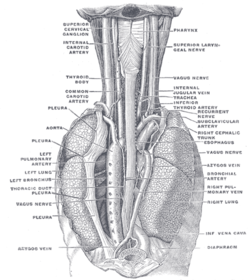Bronchial artery
| Bronchial artery | |
|---|---|

Bronchial artery labeled at center right
|
|
| Details | |
| Source | Thoracic aorta |
| Vein | Bronchial veins |
| Supplies | Lungs |
| Identifiers | |
| Latin | Arteriae bronchiales, rami bronchiales partis thoracicae aortae |
| Dorlands /Elsevier |
r_02/12689141 |
| TA | A12.2.11.002 |
| FMA | 71536 |
|
Anatomical terminology []
|
|
In human anatomy, the bronchial arteries supply the lungs with nutrition and oxygenated blood. Although there is much variation, there are usually two bronchial arteries that run to the left lung, and one to the right lung.
The left bronchial arteries (superior & inferior) usually arise directly from the thoracic aorta.
The single right bronchial artery usually arises from one of the following:
The bronchial arteries supply blood to the bronchi and connective tissue of the lungs. They travel with and branch with the bronchi, ending about at the level of the respiratory bronchioles. They anastomose with the branches of the pulmonary arteries, and together, they supply the visceral pleura of the lung in the process.
Note that much of the oxygenated blood supplied by the bronchial arteries is returned via the pulmonary veins rather than the bronchial veins. As a consequence, blood returning to the left heart is slightly less oxygenated than blood found at the level of the pulmonary capillary beds.
Each bronchial artery also has a branch that supplies the esophagus.
It is easy to confuse the bronchial arteries with the pulmonary arteries, because they both supply the lungs with blood, but there are important differences:
The bronchial arteries are typically enlarged and in chronic pulmonary thromboembolic hypertension.
With modern surgical techniques, bronchial anastomoses heal well without bronchial artery reconnection. Largely for this reason, bronchial artery circulation is usually sacrificed during lung transplants, instead relying on the persistence of a microcirculation presumably arising from the deoxygenated pulmonary circulation to provide perfusion to the airways.
...
Wikipedia
